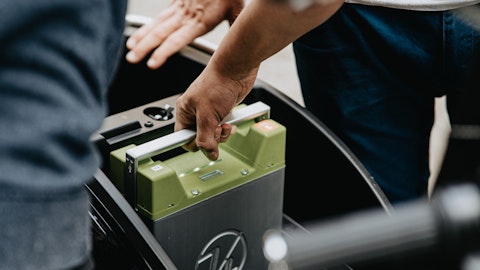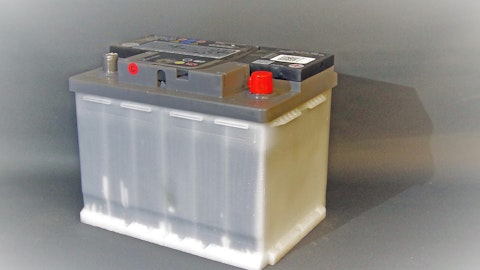And so as we look forward, we don’t see a rationale for why prices would fall to where they are because they are below reinvestment economics. As we’ve said many times, our concern would be towards the end of the decade that there needs to be a sufficient amount of capacity to serve the EV market. Here we are operating at a healthy – relatively healthy supply-demand utilization with prices where they are. So it’s very difficult to explain how that’s the case, Joel, but obviously, we’re well positioned with our cost position and our go-to-market strategy to weather that storm. It’s just – it’s going to be challenging for the industry at these levels. So that’s our greater concern is future availability and investment in supply to support the transition across the industry.
So that’s probably the best we can tell you in terms of our view at the moment.
Joel Jackson: Okay, thank you for that. If I can follow-up, on them. I think it was Kent too said, a little few minutes ago, you’re going to look at maybe ratcheting back your growth plans, it look like slightly, so slow down a little bit sequencing, but not changing anything in your longer-term plan. So what if you’re not right about your lithium price view here and what if prices are lower and the returns aren’t as good as you think and you’re going to go full team ahead on a lot of this growth, but ends up not being needed? How do you balance the risk of overspending and driving negative free cash for a long time with making sure you are supplying enough volume for the market over time and maintaining your market share?
Kent Masters: Yes. So that’s the balance, right? I think what we’re saying is we look at our capital programs, and we’re going to cut back where we can. And – but it’s not changing our overall strategy around growth – and again, our cost position protects us with that. So it’s not really the returns on the projects given what we see, but it’s more about the capital that we’re investing while the market is down. So we’re just adjusting the timing on that, and then we will be cautious as we layer those back in over time to make sure that we’re right around pricing.
Joel Jackson: Thank you.
Operator: Our next question comes from the line of Michael with Wells Fargo Securities. Michael, your line is open.
Michael Sison: Hey, guys. Scott it’s been great working with you over the last decade or so. So for 2024, can you still do or do you still expect demand to support sort of that 200,000 KTs that you’re expecting to expand to? And if you do, I guess, at these pricing levels, you could do 30% to 40% EBITDA margin?
Eric Norris: Why don’t I comment on the demand first. I think it’s an important topic, and then I’ll turn it over to Scott. This is Eric speaking. A couple of facts just to get a flavor of our business today. All of our contracts are performing. We’re able to sell product into the spot markets for that 20%. There is a lot of negative sentiment broadly in sort of media around the marketplace. It happens to be around maybe certain manufacturers announcements. I think you can’t lose sight of the fact that the bigger markets, China, are the bigger producers in the EV space, are continuing to grow their output, and that’s driving healthy demand. It is true that this year demand from a production standpoint – the need for new production is probably underperformed the 40% growth.
So the market for consumption it’s been closer to 35% growth year-on-year, where the EV market is growing at 40%, and that’s because of the inventory correction we see or have seen – but looking forward, that’s not a sustainable trend once inventory is running its course, there is a return to normalcy and/or potentially even a restocking that occurs. So we feel very good about what – we see what’s happening now is road bumps, but certainly not a determinant for the long-term growth we have. And as we look out to 2024, we will be bringing on capacity that will allow us to put against those contracts, as I said, are performing well, another double-digit year growth in 2024. As for margins, I’ll let Scott comment.
Scott Tozier: Yes. Thanks, Eric. So I think the way you should think about this is we’ve kind of illustrated on Slide 15 of our deck, we’re going to continue to see some level of the spodumene inventory lag affecting us in the first half of next year. And then by the second half, we will be in that kind of normalized 30% to 40% range that I talked about. So the full year is likely to be lower than that. However, we will get to normalized margins by the second half of the year, again, assuming if prices remain constant through that period. And we don’t see the price volatility that causes these ups and downs.
Michael Sison: And then I guess, if the industry is running in the mid-90s, and let’s just say demand does continue to grow next year. Stability in pricing hasn’t been the case, right, for the last year or so? I mean do you think there is potential for a quick rise again in pricing? Would that happen if prices – if folks restock?
Kent Masters: So look, this is – this industry – it’s still early in the industry, so it’s difficult to say. So we were anticipating some of the volatility coming out in this cycle, but that didn’t really happen. So it is difficult to say exactly how quick it responds, where it goes and where it comes back to. We anticipate over time the highs and lows in that volatility coming out. But the question is, what is that period of time?
Michael Sison: Got it. Thank you.
Operator: Our next question comes from the line of Jeff with JPMorgan. Jeff, your line is open.
Jeffrey Zekauskas: Thanks very much. Your cash flow through the first 9 months was $1.45 billion and you’re expecting cash flow for the year of $600 million to $800 million. Why is the cash flow in the fourth quarter, negative 6% or negative 8%? Is that one-time? Is it ongoing? And what do you make that?
Scott Tozier: Thanks, Jeff, for the question. So I think a couple of things are doing that. Of course, we’ve got lower EBITDA in the fourth quarter. As we look at our sales patterns, we’re back-end loaded in the quarter. So we have increased working capital as a result of that. And then we’ve got some one-time items, including the DOJ and SEC settlement that we did that flows through our operating cash flow. So those are the key drivers. And then right now, our CapEx is on track to be about the same as what it was in the third quarter. So those are kind of the moving pieces in our cash flow for the fourth quarter.





